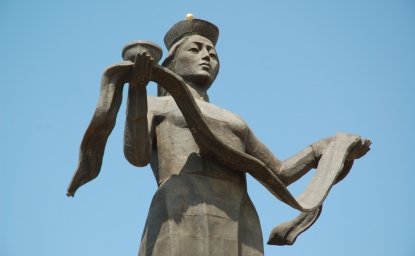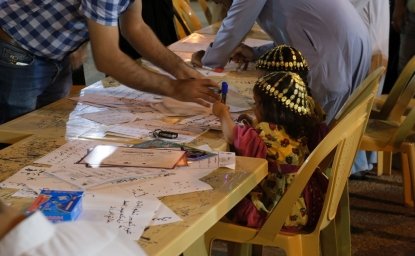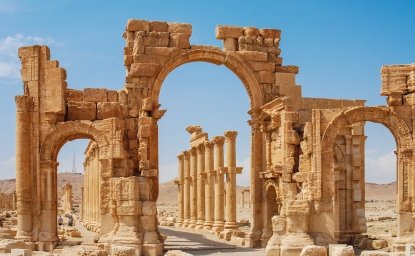322. Eastern Europe's Romani Media: An Introduction

Peter Gross is Professor and Gaylord Family Chair in International Communication and Director of the Institute for Research and Training, Gaylord College of Journalism and Mass Communication at the University of Oklahoma. He spoke at an EES noon discussion on March 22, 2006. The following is a summary of his presentation. Meeting Report 322.
Among the wealth of ethnic media outlets in Eastern Europe, the Romani media has grown faster than all others despite small audiences, poverty, illiteracy and the absence of cultural, linguistic, political and social cohesiveness of their natural constituency in the region. Consequently, except for their potential symbolic value, the growth of the Romani media appears to defy the customary functions, roles and effects of minority media: to aid in minority identity creation, cultural preservation and political participation.
The end of Communism afforded Roma opportunities to end their political marginalization. Yet, according to J.F. Brown, the preoccupation of the region's governments "still centers not on what can be done for them, but what can be done about them." Despite the efforts of the EU, the Council of Europe and Western non-governmental organizations (NGOs) to aid the establishment of Romani institutions, media, education and training programs, the Roma's access to information and media distribution outlets is poor. For instance, Daniela Hivesova-Silanova, the editor of the Slovak-based Romano Nevo lil, told the Roma Press Agency that, "Although the constitution of the Slovak Republic guarantees the Roma ethnic group the development of a national press, in reality the Roma media is financed without a system that protects its basic function."
Given the importance of media outlets in social mobilization, building ethnic identity, political engagement, cultural life and establishing a unified Romani voice, Zoltan Barany writes that "it is particularly important that the group control (and, preferably, own) media outlets…or at the very least maintain connections to sympathetic media agencies." Such control and ownership is especially important for the Romani media's potential in counteracting the non-Romani media's unrelenting propagation of the most negative stereotypes of the Roma, as well as their contribution to shaping the highly constricted economic, political and social space in which the Roma are forced to function.
The inchoate process of establishing Romani media and programs is evolving in a milieu in which the Roma are still wrestling with many seemingly intractable problems. The most important of these problems are the elimination of illiteracy, securing access to educational opportunities and having the financial wherewithal to own radios and television sets, subscribe to their programs and purchase print media. Additionally, there is indifference to (or less than overwhelming popular support for) the establishment of Romani media. In Bulgaria, for instance, a 2003 survey showed that 63 percent of Bulgarians supported the right of minorities to have their own newspapers, 31 percent supported minorities having broadcasts in their mother tongue on the national television, and 30 percent supported minorities having their own television.
The Roma have had a rough time negotiating even with European institutions and officials who are committed to helping them but who, according to a May 12, 2001 account in the Economist "do not trust Gypsy leaders enough, yet, to let them administer a single euro." This alleged attitude and behavior appears to extend to the Romani media as well. Vasile Ionescu, editor of Aven amentza a Bucharest-based newspaper financed by the Romanian Ministry of Culture and Religions, says that when the EU engages in aiding the Romani media, it works without consulting them. This needs to change if policies are to be effectively implemented and monitored. As, Maria Fernanda Perez-Solla writes, "a process blind to the point of view of the beneficiaries," may be "formally satisfactory but will lack substance."
The relationships between the Romani media and Eastern European governments and leaders are no better and the Roma have complained of their patronizing and controlling attitudes and behaviors when it comes to aiding the Romani media. For instance, Ivan Vesely, a Romani media entrepreneur in the Czech Republic, publisher of the magazine Amaro Gendalos and owner of Radio Rota, says the Czech government's condition for supporting publications is that they be in both Czech and Romani languages.
Romani media in the postcommunist world
Establishing the exact number of Romani media outlets is a difficult task because some have short life-spans, others are only sporadically available and, most importantly, there is no central institution or organization that can keep track of developments in every sphere of Europe's Romani communities. According to my research, the number of active, sometimes active, dormant, or failed Roma media outlets and programs from 1990 to 2004 included 58 periodicals, 54 radio and 22 television stations and programs, 11 news agencies and 37 websites. It should be noted that some of these are media owned and staffed by Roma, while others represent media and programs directed at the Roma population but not owned and staffed by Roma. Furthermore, Romani media programs and publications can be in one of the Romani dialects, in the vernacular, bilingual or multi-lingual, i.e., in Romani, in the vernacular and in English. The latter is meant to facilitate access to Romani media by non-Romani politicians, the Roma elite throughout the continent and others in and outside the region.
The high rate of illiteracy, the lack of a unitary culture and language, and the absence of a culture of reading mean that print media is a less than optimal way of reaching Romani audiences. Broadcast media appears to be preferable, but in this case the abject poverty of the majority of Roma precludes the establishment of many broadcast outlets and the dissemination of Roma programs on non-Roma stations, as it does the widespread ownership of television sets, if not of radios, according to most anecdotal evidence. Access to the Internet demands access to computers and a modicum of computer literacy, both of which are lacking among the overwhelming number of Roma.
The circulation of Romani print media appears to be in the hundreds and therefore miniscule in relationship to the potential Romani public. The Czech-based Amaro Gendalo, for example, publishes 3,000 copies per issue in a country that has a reported 300,000 Roma. In Romania, Aven amentza claims to have 2,000 readers in a country with nearly 2 million Roma. The size of the audience for Romani radio and television stations is unknown. In Hungary, according to Gabor Bernath and Vera Messing, the Romani newspapers are not the most popular medium of the Roma. By other accounts, it appears that the large majority of Roma are either disinterested in Roma periodicals or cannot afford them. This begs the question: Who is the target audience for the Romani media?
The majority of the Roma appear not to be the intended target of the Romani media and this assertion is supported by the testimony of Romani leaders who admit that there is a "cultural distance" between the Romani intellectuals who own, edit and contribute to the Romani media, and non-elites. Instead, the intent of most Romani media is to provide vehicles that allow communication among the Roma elite, with non-Romani politicians in Eastern and Western Europe, with Roma and non-Roma who are interested in Romani culture but who live in a different part of the world. For example, the Aven amentza is published only in Romanian and is not directed at the Roma at all, but at the Romanian elite. In Macedonia, the Romani television stations TV BTR National and TV Sutel appeal to both Romani and Macedonian viewers.
Compounding these problems, according to Istvan Poganyi, is the abandonment by successful, upwardly mobile Roma of any public links to their ancestral community and, in turn, their image as ‘alien' or ‘different' among the majority of the downwardly-mobile Roma who do not recognize the successful Roma as constituting part of a collective ‘self.' There are exceptions to what appears to be the rule. In Romania, for example, if we are to believe Viorel Achim, Romani intellectuals are engaged in modernizing their communities and, simultaneously, establishing a sense of ethnic consciousness through their media.
Yet, the lack of readership, in particular, means that newspaper and magazine runs often remain unsold. Given the low readership and purchasing power of most Roma, the uncertain size of the broadcast audience and anti-Roma discrimination, few businesses are willing to advertise in the Romani media. There is, therefore, a continued need to rely on financial support from governments, EU institutions, and NGOs.
There are also practical problems facing the Roma media. First, there are no Romani distribution networks and Romani media has limited access to non-Romani networks. In Romania and Hungary, for instance, established distributors simply will not take on the distribution of Romani newspapers. And even when Romani publications do make it to the newsstands, they are often displayed at the bottom of a rack or under other papers. Second, the dearth of Romani journalists and editors continues to be a big problem, which is only now being addressed by a host of training programs. Even so, these training programs do not resolve the Romani media's personnel problems because many Romani journalists prefer to work for non-Romani media, which offer more prestigious and better paid jobs. Third, there is an absence of a clear sense of who the audience is and what they want. Fourth, the lack of a viable economic basis and control over finances means that money to establish and sustain Romani media is scarce and, as already mentioned, most of it is offered by European institutions, NGOs, and governments in the region. Ultimately, as Nicolae Gheorghe, one of Europe's and Romania's Romani leaders, says, "We will be able to discuss how to organize our media and how to develop it when we are able to pay for it ourselves." Related to the lack of financing is the problem of the general poor state of the technical endowment of Romani media. In Macedonia, for example, Romani broadcasters lack not only the manpower but work with obsolete equipment and therefore experience frequent technical problems.
In the absence of a substantial Romani audience, financial wherewithal, a sufficient number of media personnel, and a clear vision of whom it serves and what role and function it plays, the Romani media appears to fulfill only a symbolic role inside and outside its natural constituency. What form and import this symbolic role takes is not clear.
The role, function, and import of Romani media
A point-by-point examination of the role and import of the Romani media, as described with Panglossian enthusiasm by the Roma Media Networking Project, suggests robust roles, functions and importance:
1) Roma media plays an important role in shaping the way Roma perceive themselves, their culture and traditions, their social and economic situation, discrimination and their rights.
2) First and foremost, Roma media serves as a means of self-assertion for a whole people who, for many centuries, have been brutally oppressed.
3) Roma media provides an invaluable means for the preservation of Roma language and culture, while at the same time fostering communication within a larger circle of Roma communities striving for emancipation and inclusion as equal citizens.
4) Finally, by supplying mainstream media with quality features related to Roma issues, it can influence mainstream media coverage and Gadje (non-Roma) society in a positive sense.
I contend, however, that given the circumstances in which Romani media operates, this list of functions and roles amounts to wishful thinking. After all, how can Romani media play an important role if it only reaches a miniscule fraction of the Romani population and has not established itself as the central facilitator of Romani public opinion formation? Furthermore, according to Orhan Galjus, most of the Romani media outlets "have yet to devote enough energy to wider problems … education, employment, culture, language, emancipation in [the] general sense, political participation, social exclusion and discrimination, as well as to positive examples." More importantly, Romani media still lacks real political and public influence. Zoltan Barany writes that "Romani activists often complain that political and socioeconomic issues comprise an all too small share of program content" in Romani broadcasts. Thus, what is it that the Romani media intends to accomplish given the nature of its content? Do Romani media outlets have clear media identities?
In terms of serving as a means for Roma self-assertion, do the Romani elites who own, control and contribute to the Romani media speak for all Roma? And how do the Romani media serve as a means of self-assertion for the Roma when much of the Romani media is only partially staffed by Romani journalists? Both Amaro Gendalo and Aven amenza, for instance, have non-Romani journalists working on their publications. The same is true at the Romani radio and television stations in Macedonia. One tentative conclusion is that the Romani web sites may serve as conduits to transnational organizing, involving mostly the Roma elites.
It is difficult to believe, moreover, that Romani media fosters "communication within a larger circle of Roma communities" given that the Romani media (with the exception of some regional and international radio and Romani websites) does not reach more than one Romani community in the region. Donald Browne concludes, "Because most Roma services are local, and much of their output is in national languages rather than Romany, their ability to exchange program material (aside from music) is decidedly limited." In terms of preserving language and culture, it is important to ask which of the many subcultures and languages or dialects are the Romani media preserving?
Finally, to date, there has been practically no or painfully little contact between Romani and mainstream media, let alone a positive influence on the portrayals of Roma. As Andrzej Mirga describes the situation, "the Romani media and the non-Romani media are two non-intersecting circles" and even if the Romani and non-Romani media were to have a working relationship, it appears the Romani media, in particular the Romani press, "cannot praise [themselves] for being the best provider[s], producer[s], and recorder[s] of most detailed information about Romani lives." Despite the relatively international audiences of some, the Romani media has not motivated the international audience to consider Romani lives as a whole with importance.
These questions and perhaps harsh assessments of the Romani media—juxtaposed with the seemingly idealistic vision that some have of their functions, roles and import—can only be answered by a concerted research program that should employ content analyses, surveys of audiences, individual and focus group interviews, among other data and information gathering methodologies.
Given their small Romani audiences, the unknown currency they have inside and outside the Romani communities and their elites, Romani media appears not to have significant identity creation, cultural preservation and participatory functions. Credible, authoritative knowledge and understanding of what, how and for whom the Romani media exists, and what roles, functions and import it has are missing. Conclusive analysis and theoretical models are not yet available. Even basic questions about the organization, management, staffing, circulation, readership, viewership and listenership of Romani media is yet to be authoritatively answered. A thorough probing of the nature, ethos and political, social and cultural underpinnings of the Romani media remains to be accomplished.
Author

Global Europe Program
The Global Europe Program is focused on Europe’s capabilities, and how it engages on critical global issues. We investigate European approaches to critical global issues. We examine Europe’s relations with Russia and Eurasia, China and the Indo-Pacific, the Middle East and Africa. Our initiatives include “Ukraine in Europe”—an examination of what it will take to make Ukraine’s European future a reality. But we also examine the role of NATO, the European Union and the OSCE, Europe’s energy security, transatlantic trade disputes, and challenges to democracy. The Global Europe Program’s staff, scholars-in-residence, and Global Fellows participate in seminars, policy study groups, and international conferences to provide analytical recommendations to policy makers and the media. Read more

Explore More
Browse Insights & Analysis
Talking to the Dead to Heal the Living

Russia’s Indigenous Communities and the War in Ukraine

